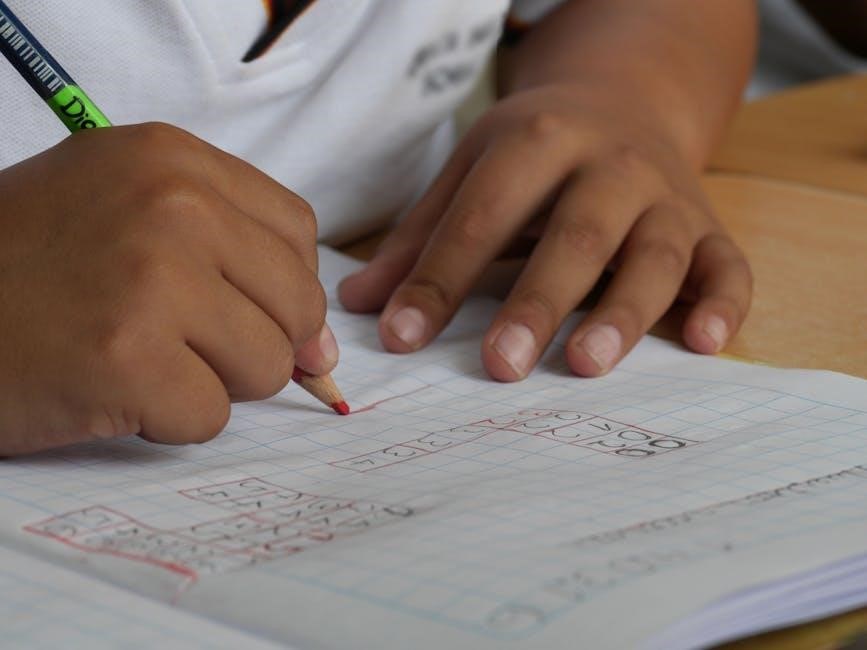The Grade 7 Math Workbook PDF is a comprehensive resource designed to support students in mastering key math concepts. It aligns with the Grade 7 math curriculum, offering practice exercises, lesson tests, and extra practice materials. The workbook is structured to reinforce understanding of topics like integers, fractions, data handling, and simple equations. It also includes sections on geometry and probability, making it a versatile tool for both classroom and home study. The PDF format ensures easy access and portability, allowing students to practice anytime, anywhere. This workbook is an excellent supplement to traditional textbooks and online resources, helping students build confidence and fluency in their math skills.
Overview of the Workbook
The Grade 7 Math Workbook PDF is a structured, comprehensive resource tailored to meet the learning needs of students. It covers a wide range of math topics, including integers, fractions, data handling, and simple equations, with dedicated sections for geometry and probability. The workbook includes practice worksheets, lesson tests, and an answer key, ensuring thorough reinforcement of concepts. Designed to complement textbooks and online resources, it offers flexibility for both classroom and home study. Its clear layout and organized content make it an ideal tool for building math fluency and confidence in Grade 7 students.
Importance of Using a Workbook for Grade 7 Math
A Grade 7 Math Workbook PDF is an essential tool for reinforcing math skills and building confidence. It provides structured practice exercises that align with the curriculum, ensuring a strong foundation in concepts like integers, fractions, and geometry. Regular use of the workbook helps students develop problem-solving abilities and fluency in calculations. The portable PDF format allows for anytime, anywhere practice, making it ideal for homework or supplementary study. By offering clear examples and comprehensive coverage, the workbook supports both classroom learning and independent practice, fostering academic success in Grade 7 math.
Key Features of a Grade 7 Math Workbook
A Grade 7 Math Workbook PDF offers a variety of features to enhance learning. It includes comprehensive practice exercises, lesson tests, and extra practice materials to reinforce math skills. The workbook covers key topics like integers, fractions, data handling, and geometry, with clear examples and step-by-step solutions. Additional resources such as answer keys and progress tracking tools are included to support independent study. The PDF format ensures accessibility across devices, making it easy for students to practice at home or in class. These features make the workbook an invaluable resource for mastering Grade 7 math concepts effectively.
Chapter 1: Integers
Integers are whole numbers, including negatives, positives, and zero. This chapter covers operations with integers, absolute values, and practical applications, building a strong foundation for higher math concepts.
Operations with Integers
Operations with integers include addition, subtraction, multiplication, and division of positive and negative whole numbers. Understanding these operations is fundamental for solving algebraic expressions and real-world problems. The workbook provides exercises on adding and subtracting integers, multiplying and dividing with negative numbers, and applying the distributive property. Students learn to apply rules for signs, such as the result of a negative times a negative being positive. Practical examples and step-by-step solutions help reinforce these concepts, ensuring a solid foundation in integer operations for higher-level math.
Absolute Value and Integer Applications
Absolute value represents the distance of an integer from zero on the number line, regardless of direction. The workbook explores absolute value concepts through exercises and real-world applications, such as temperature changes and financial transactions. Students learn to interpret absolute value as a measure of magnitude and apply it to solve practical problems; Integer applications are also highlighted, showing how integers are used in everyday scenarios like measuring quantities, calculating debts, and determining scores. These lessons bridge theory with practical usage, enhancing problem-solving skills and real-world applicability.

Chapter 2: Fractions and Decimals
This chapter focuses on mastering fractions and decimals, essential for building a strong foundation in math. Students learn to add, subtract, and convert between fractions and decimals, with practical applications included to reinforce understanding and real-world relevance.
Adding and Subtracting Fractions
This section provides detailed practice in adding and subtracting fractions, focusing on finding common denominators and simplifying results. Students engage with guided exercises, mixed practice sets, and real-world application problems to build fluency. The workbook includes clear examples, step-by-step instructions, and ample space for calculations. Answers are provided for immediate feedback, helping students identify areas for improvement. Additional challenges, such as word problems, encourage critical thinking and practical math skills. This comprehensive approach ensures mastery of fraction operations, a foundational skill for higher-level math.
Converting Between Fractions and Decimals
This section focuses on mastering the essential skill of converting fractions to decimals and vice versa. Clear step-by-step instructions guide students through the process, ensuring understanding of place value and equivalence. Practice exercises include converting proper fractions, improper fractions, and mixed numbers to decimals, as well as reversing the process. Real-world examples, such as measurements and money, help apply these conversions practically. The workbook also provides drills to enhance speed and accuracy, reinforcing this fundamental math skill for future topics like ratios and percentages.

Chapter 3: Data Handling
This chapter introduces students to data handling, focusing on collecting, organizing, and interpreting data. It helps students develop analytical skills through practical exercises and real-world applications.
Types of Data and Their Collection
Types of Data and Their Collection introduces students to different data categories, such as qualitative and quantitative data. It explains how to gather data through surveys, observations, and experiments. The section emphasizes organizing data into categories like age, height, or favorite color, and numerical data like test scores. Students learn to distinguish between discrete and continuous data, ensuring accurate collection methods. Practical exercises provide hands-on experience, helping students understand real-world applications of data collection and its importance in analysis and interpretation. This skill is essential for building a strong foundation in data handling and statistics.
Interpreting Data Through Graphs
Interpreting Data Through Graphs teaches students to analyze and understand visual representations of information. It covers various graph types, such as bar graphs, line graphs, and pie charts, explaining how to read and interpret data points. The section emphasizes identifying trends, comparing quantities, and understanding frequencies; Practical exercises guide students in extracting information from graphs, ensuring they can draw meaningful conclusions. This skill is vital for developing analytical thinking and preparing for more complex data analysis in higher grades. Real-world examples make learning engaging and relatable;

Chapter 4: Simple Equations
This chapter focuses on understanding and solving simple equations, building foundational algebra skills. It covers one-step and two-step equations, practical applications, and real-world problem-solving strategies for students.
Understanding and Solving Simple Equations
The workbook introduces simple equations with clear examples and step-by-step solutions. Students learn to solve one-step and two-step equations using inverse operations. Practical problems help apply these skills to real-life scenarios, reinforcing algebraic thinking. The exercises are designed to build confidence and fluency in manipulating equations. Additional practice worksheets and lesson tests ensure thorough mastery of the concept, providing a solid foundation for more complex algebraic problems later in the curriculum. The structured approach makes learning accessible and engaging for Grade 7 students.
Practical Applications of Simple Equations
The workbook highlights practical applications of simple equations in real-life scenarios, such as calculating ages, budgeting, and mixing ingredients. Students engage in word problems that simulate everyday situations, fostering problem-solving skills. Activities include determining unknown quantities, solving for variables, and interpreting results in context. These exercises bridge algebraic concepts with tangible outcomes, helping students appreciate the relevance of math in their lives. By applying simple equations to real-world problems, learners develop critical thinking and practical math skills essential for daily decision-making and future studies.

Chapter 5: Lines and Angles
This chapter focuses on lines and angles, introducing students to basic properties, types of lines, and angle measurements. It builds a foundation for geometry concepts through practical exercises and real-world applications, ensuring a clear understanding of spatial relationships and their mathematical representations.
Properties of Lines and Angles
This section explores the fundamental properties of lines and angles, such as parallel, perpendicular, and intersecting lines. Students learn to identify and classify angles as acute, obtuse, right, or straight. The workbook includes exercises on understanding angle sums, vertical angles, and supplementary angles. Practical problems help reinforce concepts like corresponding angles and alternate interior/exterior angles. These foundational skills are essential for advanced geometry topics and real-world applications in measurement and design. The PDF format allows for easy access to diagrams and practice questions, enhancing learning engagement and retention.
Measurement and Calculation of Angles
This section focuses on the measurement and calculation of angles, teaching students to use protractors accurately. Exercises include identifying acute, obtuse, and reflex angles, as well as calculating unknown angles in diagrams. The workbook provides problems involving the sum of angles in polygons and the calculation of interior and exterior angles. Real-world applications, such as measuring angles in architecture or engineering, are highlighted to emphasize practical relevance. The PDF format ensures clarity of diagrams, making it easier for students to visualize and solve problems confidently.

Chapter 6: Triangle and Its Properties
This chapter explores the properties of triangles, focusing on types like equilateral, isosceles, and scalene. It covers understanding sides, angles, and vertices, with practical applications for calculating perimeter and area.
Types of Triangles and Their Properties
The workbook introduces students to different types of triangles, including equilateral, isosceles, scalene, and right-angled triangles. Each type is explored through detailed definitions, properties, and examples. For instance, equilateral triangles have three equal sides and angles, while right-angled triangles feature a 90-degree angle. The section emphasizes understanding the unique characteristics of each triangle type, such as side lengths and angle measures. Practical exercises and diagrams help students classify triangles and apply their properties to solve problems. This foundational knowledge is essential for advanced geometry topics later in the curriculum.
Congruence and Similarity in Triangles
The workbook explores congruence and similarity in triangles, explaining how these concepts are fundamental to geometry. Congruent triangles have identical shapes and sizes, with equal corresponding sides and angles, while similar triangles have the same shape but different sizes, with proportional sides and equal angles. The section includes detailed criteria for determining congruence (e.g., SSS, SAS, ASA, AAS) and similarity (e.g., AA, SAS similarity). Practical exercises and visual aids help students apply these concepts to real-world problems, reinforcing their understanding of geometric relationships and transformations.

Chapter 7: Congruence of Triangles
This chapter focuses on the criteria for triangle congruence, including SSS, SAS, ASA, and AAS. It provides practical exercises to help students master proving triangle congruence through various methods.
Criteria for Triangle Congruence
The workbook explains the four main criteria for triangle congruence: SSS (Side-Side-Side), SAS (Side-Angle-Side), ASA (Angle-Side-Angle), and AAS (Angle-Angle-Side). Each criterion is supported by clear examples and exercises; Students learn to identify corresponding sides and angles and apply these rules to determine if triangles are congruent. The workbook also includes problems involving real-world scenarios to enhance understanding. Practical exercises help students master the application of these criteria, ensuring a solid foundation in triangle properties and congruence. This section is essential for developing geometric reasoning skills.
Proving Triangle Congruence
The workbook provides step-by-step guidance on proving triangle congruence using the SSS, SAS, ASA, and AAS criteria. It includes examples with corresponding diagrams to illustrate each proof. Students learn to apply theorems and properties to logically demonstrate congruence. Exercises are designed to reinforce the understanding of each criterion, ensuring students can identify and apply the correct method. The section aligns with curriculum standards and includes tips for avoiding common errors. Practice problems range from basic to challenging, helping students master triangle congruence proofs effectively.

Chapter 8: Percentages and Variations
This chapter focuses on understanding percentages, direct and inverse variations, and their real-world applications. It includes exercises to calculate percentages and identify variation types, with detailed solutions provided in the PDF workbook. The section emphasizes practical problems to enhance problem-solving skills and ensure a solid grasp of these essential math concepts. The content is structured to build confidence in handling percentages and variations through clear examples and practice questions.
Understanding Percentages
Understanding percentages is a fundamental skill in math, enabling students to grasp concepts like proportions, discounts, and growth rates. Percentages represent parts of a whole as hundredths, making them versatile for real-world applications; The workbook provides clear explanations and exercises to convert fractions and decimals to percentages and vice versa. Key topics include calculating percentages of numbers, percentage increase or decrease, and interpreting percentage data in graphs. Practical examples, such as calculating discounts or population growth, help students connect theory to real-life scenarios. The PDF format ensures accessibility, with visual aids like pie charts to reinforce learning. Mastering percentages builds a strong foundation for advanced math concepts and everyday problem-solving.
Direct and Inverse Variations
Direct and inverse variations are essential concepts in algebra, describing relationships between variables. In direct variation, one quantity increases as another increases, represented by ( y = kx ). Inverse variation shows one quantity increasing as the other decreases, modeled by ( y = rac{k}{x} ). These concepts are crucial for solving real-world problems, such as calculating speed, distance, and time, or understanding proportional relationships. The workbook provides clear explanations, practical examples, and exercises to help students master these variations, ensuring they can apply them confidently in various mathematical and real-life scenarios.
Chapter 9: Similar Figures and Scale Drawings
The chapter introduces similar figures and scale drawings, focusing on identifying similarity, calculating scale factors, and applying these concepts to solve geometric problems. Practice exercises and real-world applications are included.
Identifying Similar Figures
Identifying similar figures involves determining if two shapes have the same shape but not necessarily the same size. This is done by checking if corresponding angles are equal and corresponding sides are in proportion; The workbook provides exercises to practice identifying similar figures using diagrams and calculations. Students learn to verify similarity by comparing measurements and using scale factors. Practical examples, such as comparing blueprints to actual structures, help reinforce the concept. The exercises also include matching games and true/false questions to assess understanding. This skill is essential for advanced geometry and real-world applications.
Creating Scale Drawings
Creating scale drawings involves representing actual objects or spaces in a reduced or enlarged size while maintaining proportion. Students learn to use scale factors to ensure accuracy. The workbook provides step-by-step guides for scaling up or down, with exercises on converting measurements and calculating ratios. Practical examples, such as drawing floor plans or map sections, help apply the concept. Activities include matching scale models to their actual sizes and calculating distances on scaled diagrams. This skill enhances spatial reasoning and is vital for fields like architecture and engineering.

Chapter 10: Probability
This chapter introduces students to the basics of probability, including understanding likelihood, calculating probabilities, and applying concepts to real-world scenarios. It builds foundational skills for data analysis and decision-making through practical exercises and examples, helping students grasp the importance of probability in everyday life and future studies.
Basic Concepts of Probability
Probability is a measure of the likelihood of an event occurring, ranging from 0 to 1. A probability of 0 means the event is impossible, while 1 means it is certain. Students learn to identify possible and certain events, understand probability as a fraction or decimal, and recognize that probabilities near 1 indicate likely events. Practical examples, such as flipping a coin or rolling a die, help students grasp these concepts. The workbook includes exercises to calculate probabilities and interpret results, preparing students for real-world applications and more complex probability problems in higher grades.
Calculating Probability in Real-World Scenarios
Learning to calculate probability in real-world scenarios helps students apply math to everyday situations. The workbook provides exercises on predicting weather outcomes, determining sports game results, and analyzing random events like drawing cards or flipping coins. Students practice calculating probabilities for multiple outcomes and interpreting results. Practical examples, such as determining the likelihood of winning a raffle or selecting a specific item from a set, enhance understanding. These exercises improve critical thinking and problem-solving skills, preparing students to tackle more complex probability challenges in real-life contexts. The workbook ensures a solid foundation for practical probability applications.

Practice and Homework Resources
The workbook includes extra practice, lesson tests, and an answer key, offering comprehensive support and reinforcing math skills in a structured, accessible format.
Activating Prior Knowledge
Activating Prior Knowledge in the Grade 7 Math Workbook PDF helps students review fundamental concepts before diving into new material. This section provides a brief introduction to essential math skills, along with examples and check questions to ensure readiness for upcoming lessons. It reinforces previously learned material, such as basic operations with integers, fractions, and decimals, and introduces key ideas like simple equations and data handling. By revisiting these topics, students build a strong foundation and transition smoothly into more complex math concepts, ensuring a confident start to their learning journey.
Extra Practice and Lesson Tests
The Grade 7 Math Workbook PDF includes extra practice worksheets and lesson tests to reinforce learning and prepare students for assessments. These resources are organized by chapter and lesson, ensuring targeted practice for each math concept. The extra practice provides additional exercises for challenging topics, while lesson tests help students assess their understanding after completing each lesson. An answer key is also provided, allowing students to check their work and identify areas for improvement. These tools help build confidence and ensure mastery of the curriculum material. Regular practice with these resources enhances problem-solving skills and math fluency.
Math Mammoth Grade 7 Complete Curriculum
The Math Mammoth Grade 7 Complete Curriculum is a comprehensive, well-structured program aligned with typical pre-algebra courses. It offers a logical progression of math topics, ensuring a strong foundation for further studies while remaining adaptable for use with other curricula.
Structure and Content
The Math Mammoth Grade 7 Complete Curriculum is organized into clear chapters, each focusing on specific math topics such as integers, fractions, and geometry. The workbook includes detailed practice worksheets, lesson tests, and an answer key, ensuring comprehensive coverage of skills. Designed to align with typical pre-algebra standards, it offers a logical progression of lessons, making it easy for students to build on prior knowledge. The content is adaptable, allowing it to complement various math curricula seamlessly. This structure provides a balanced approach to learning, catering to different learning styles and pacing needs.
Using the Workbook with Other Curricula
The Grade 7 Math Workbook PDF is versatile and can be easily integrated with other math curricula. Its content aligns with typical pre-algebra standards, making it suitable for use alongside various teaching materials. The workbook’s structure allows it to complement both traditional textbooks and online resources effectively. Whether used as a supplement or a standalone practice tool, it provides consistent reinforcement of math concepts. This adaptability ensures that students can apply the skills they learn in class or through other programs, enhancing their overall math proficiency.
The Grade 7 Math Workbook PDF is a valuable tool for mastering math concepts, building confidence, and fostering problem-solving skills. Its comprehensive exercises and practical applications ensure effective learning and long-term success in mathematics.
Benefits of Using a Grade 7 Math Workbook
A Grade 7 Math Workbook PDF offers numerous benefits, including comprehensive practice exercises that reinforce learning and build confidence. It provides structured lessons and extra practice materials, helping students master key concepts like integers, fractions, and geometry. The workbook’s portability and accessibility in PDF format make it ideal for studying at home or on the go. Regular practice with the workbook improves problem-solving skills, fluency, and understanding of mathematical principles. It also includes lesson tests and answer keys, enabling students to track their progress and identify areas for improvement. This resource is essential for achieving long-term success in mathematics.
Final Tips for Effective Workbook Use
To maximize the benefits of a Grade 7 Math Workbook PDF, establish a structured study schedule and dedicate time to practice regularly. Break down complex problems into smaller, manageable steps to enhance understanding. Review mistakes promptly and seek clarification on challenging topics. Utilize the answer keys provided to assess progress and identify areas needing improvement. Encourage active learning by attempting questions independently before referencing solutions. Incorporate real-world examples to apply mathematical concepts practically. Consistent effort and proactive learning will lead to improved problem-solving skills and overall academic success.
